 W
WĀdi purāṇa is a 9th century Sanskrit poem composed by Jinasena, a Digambara monk. It deals with the life of Rishabhanatha, the first Tirthankara.
 W
WAntakrddaaśāh is the eighth of the 12 Jain āgamas said to be promulgated by Māhavīra himself. Antakrddaaśāh translated as "Ten Chapters on End-Makers" is said to have been composed by Ganadhara Sudharmaswami as per the Śvetámbara tradition.
 W
WBhaktamara Stotra is a famous Jain Sanskrit prayer. It was composed by Acharya Manatunga. The name Bhaktamara comes from a combination of two Sanskrit names, "Bhakta" (Devotee) and "Amar" (Immortal).
 W
WCīvaka Cintāmaṇi, also spelled as Civaka Cintamani, is one of the five great Tamil epics. Authored by a Madurai-based Jain ascetic Tiruttakkatēvar in the early 10th century, the epic is a supernatural fantasy story of a prince who is the perfect master of all arts, perfect warrior and perfect lover with numerous wives. The Civaka Cintamani is also called the Maṇanūl. The epic is organized into 13 cantos and contains 3,145 quatrains in viruttam poetic meter. Its Jain author is credited with 2,700 of these quatrains, the rest by his guru and another anonymous author.
 W
WAgamas are texts of Digambara Jainism based on the discourses of the tirthankara. Pravachanasara, Samaysara, Niyamsara, Pancastikayasara, Ashtapahuda, Kasayapahuda and Shatkhandagama are considered Agamic Texts by Digambaras.
 W
WDravyasaṃgraha is a 10th-century Jain text in Jain Sauraseni Prakrit by Acharya Nemicandra belonging to the Digambara Jain tradition. It is a composition of 58 gathas (verses) giving an exposition of the six dravyas (substances) that characterize the Jain view of the world: sentient (jīva), non-sentient (pudgala), principle of motion (dharma), principle of rest (adharma), space (ākāśa) and time (kāla). It is one of the most important Jain works and has gained widespread popularity. Dravyasaṃgraha has played an important role in Jain education and is often memorized because of its comprehensiveness as well as brevity.
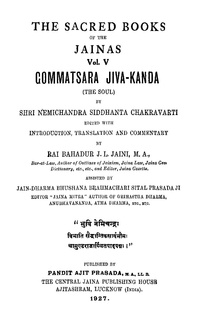 W
WGommatsāra is one of the most important Jain texts authored by Acharya Nemichandra Siddhanta Chakravarti.
 W
WJain literature comprises Jain Agamas and subsequent commentaries on them by various Jain ascetics. Jain literature is primarily divided between Digambara literature and Śvētāmbara literature. Jain literature exists mainly in Magadhi Prakrit, Sanskrit, Marathi, Tamil, Rajasthani, Dhundari, Marwari, Hindi, Gujarati, Kannada, Malayalam, Tulu and more recently in English.
 W
WIn Jainism, Jinvani means the message or the teachings of the Jina (arihant). It is made up of two words Jina (arihant) and Vani (voice). Often the words are spelled out separately or put together as "Jinavani" in publications. It is depicted in various forms, such as "Jinwani" which may be a hymn, and is also personified as Jinvani Maa. The omniscient form of Jina-Vani is said to be a letterless speech, when emanating from an arihant, which is understandable by all present, in their own language, as it is transformed into lettered discourse. In literature, discourses of the tirthankara are generally referred to as Jinvani, as well as Srutu Jnana, meaning scriptural knowledge.
 W
WThe Kalpa Sūtra is a Jain text containing the biographies of the Jain Tirthankaras, notably Parshvanatha and Mahavira. Traditionally ascribed to Bhadrabahu, which would place it in the 4th century BCE, it was probably put in writing 980 or 993 years after the Nirvana (Moksha) of Mahavira.
 W
WKasayapahuda is one of the oldest canonical text of the Digambara Jains. Another oldest canonical text, the Shatkhandagama was written about the same time. Both these texts are held in high esteem by the Digambaras. Kasaya (passions) form the subject matter of Kasayapahuda.
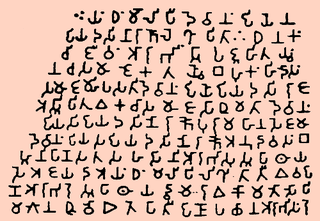 W
WLipi means "writing, letters, alphabet", and contextually refers to scripts, the art or manner of writing, or in modified form such as lipī (लिपी) to painting, decorating or anointing a surface to express something.
 W
WMahapurana (महापुराण) or Trishashthilkshana Mahapurana is a major Jain text composed largely by Acharya Jinasena during the rule of Rashtrakuta ruler Amoghavarsha and completed by his pupil Gunabhadra in the 9th century CE. Mahapurana consists of two parts. The first part is Ādi purāṇa written by Acharya Jinasena. The second part is Uttarapurana which is the section composed by Gunabhadra.
 W
WMahavira: The Hero of Nonviolence is an illustrated children’s story based upon the life of Mahavira, a teacher of the Jain faith.
 W
WThe 'Ṇamōkāra mantra/Navkar Mantra is the most significant mantra in Jainism. This is the first prayer recited by the Jains while meditating. The mantra is also variously referred to as the Pancha Namaskāra Mantra, Navakāra Mantra or Namaskāra Mantra.
 W
WNirvana Kanda is an ancient Prakrit Jain composition that describes the sacred sites where Jain sages have attained Nirvana. It is also termed Nirvana Bhakti.
 W
WNiyamasara is a Jain text authored by Acharya Kundakunda, a Digambara Jain acharya. It is described by its commentators as the Bhagavat Shastra. It expounds the path to liberation.
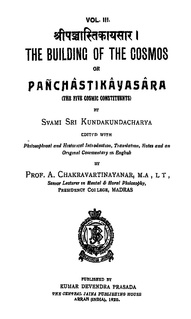 W
WPañcastikayasara, is an ancient Jain text authored by Acharya Kundakunda. Kundakunda explains the Jain concepts of dravya (substance) and Ethics. The work serves as a brief version of the Jaina philosophy. There are total 180 verses written in Prakrit language. The text is about five (panch) āstikāya, substances that have both characteristics, viz. existence as well as body.
 W
WPravachanasara, is a text composed by Jain monk, Kundakunda, in the second century CE or later. The title means "Essence of the Scripture", and it largely deals with the correct ascetic and spiritual behavior based on his dualism premise. Kundakunda provides a rationale for nudity among Digambara monks in this text, stating that the duality of self and of others means "neither I belong to others, nor others belong to me, therefore nothing is mine and the ideal way for a monk to live is the way he was born". The text is written in Prakrit language, and it consists of three chapters and 275 verses.
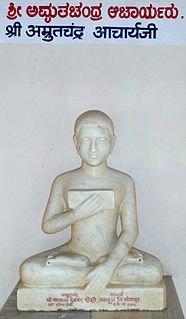 W
WPuruşārthasiddhyupāya is a major Jain text authored by Acharya Amritchandra. Acharya Amritchandra was a Digambara Acharya who lived in the tenth century. Puruşārthasiddhyupāya deals with the conduct of householder (sravak) in detail. Another major Jain text that deals with householder's conduct is Ratnakaranda śrāvakācāra. Puruşārthasiddhyupāya also deals extensively with the Jain concept of ahiṃsā.
 W
WRatnakaranda śrāvakācāra is a Jain text composed by Aacharya Samantbhadra Swamy, an acharya of the Digambara sect of Jainism. Aacharya Samantbhadra Swamy was originally from Kanchipuram, Tamil Nadu. Ratnakaranda śrāvakācāra is the earliest and one of the best-known śrāvakācāra.
 W
WSamayasāra is a famous Jain text composed by Acharya Kundakunda in 439 verses. Its ten chapters discuss the nature of Jīva, its attachment to Karma and Moksha (liberation). Samayasāra expounds the Jain concepts like Karma, Asrava, Bandha (Bondage), Samvara (stoppage), Nirjara (shedding) and Moksha.
 W
WSarvārthasiddhi is a famous Jain text authored by Ācārya Pujyapada. It is the oldest commentary on Ācārya Umaswami's Tattvārthasūtra. A commentary is a word-by-word or line-by-line explication of a text.
 W
WThe Ṣaṭkhaṅḍāgama is the foremost and oldest Digambara Jain sacred text.
 W
WCilappatikāram, also referred to as Silappathikaram or Silappatikaram, is the earliest Jain Tamil epic. It is a poem of 5,730 lines in almost entirely akaval (aciriyam) meter. The epic is a tragic love story of an ordinary couple, Kannaki and her husband Kovalan. The Silappathikaram has more ancient roots in the Tamil bardic tradition, as Kannaki and other characters of the story are mentioned or alluded to in the Sangam literature such as in the Naṟṟiṇai and later texts such as the Kovalam Katai. It is attributed to a prince-turned-monk Iḷaṅkõ Aṭikaḷ, and was probably composed in the 5th or 6th-century CE.
 W
WSutra in Indian literary traditions refers to an aphorism or a collection of aphorisms in the form of a manual or, more broadly, a condensed manual or text. Sutras are a genre of ancient and medieval Indian texts found in Hinduism, Buddhism and Jainism.
 W
WTattvartha Sutra is an ancient Jain text written by Acharya Umaswami (Umaswami), sometime between the 2nd- and 5th-century AD. It is one of the Jain scriptures written in the Sanskrit language. The term Tattvartha is composed of the Sanskrit words tattva which means "reality, truth" and artha which means "nature, meaning", together meaning "nature of reality".
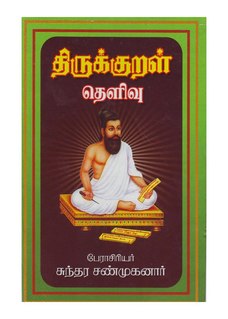 W
WThe Tirukkural, or shortly the Kural, is a classic Tamil language text consisting of 1,330 short couplets of seven words each, or kurals. The text is divided into three books with aphoristic teachings on virtue, wealth and love, respectively. Considered one of the greatest works on ethics and morality, it is known for its universality and secular nature. Its authorship is traditionally attributed to Valluvar, also known in full as Thiruvalluvar. The text has been dated variously from 300 BCE to 5th century CE. The traditional accounts describe it as the last work of the third Sangam, but linguistic analysis suggests a later date of 450 to 500 CE and that it was composed after the Sangam period.
 W
WUttaradhyayana or Uttaradhyayana Sutra is one of the most important sacred books of the Svetambara Jains. It consists of 36 chapters, each of which deals with aspects of Jain doctrine and discipline.It is believed by some to contain the actual words of Bhagwan Mahavira.
 W
WUttarapurana is a Jain text composed by Acharya Gunabhadra in the 9th century CE. According to the Digambara Uttarapurana text, Mahavira was born in Kundpur in the Kingdom of the Videhas.
 W
WVividha Tirtha Kalpa is a widely cited Jain text composed by Jinaprabha Suri in the 14th century CE. It is a compilation of about 60 Kalpas (sections), most of them give the accounts of major Jain Tirthas.
 W
WYogaśāstra is a 12th-century Sanskrit text by Hemachandra on Svetambara Jainism. It is a treatise on the "rules of conduct for laymen and ascetics", wherein "yoga" means "ratna-traya", i.e. right belief, right knowledge and right conduct for a Svetambara Jain. As a manual with an extensive auto-commentary called Svopajnavrtti, it was instrumental to the survival and growth of Svetambara tradition in western Indian states such as Gujarat and the spread of Sanskrit culture in Jainism.